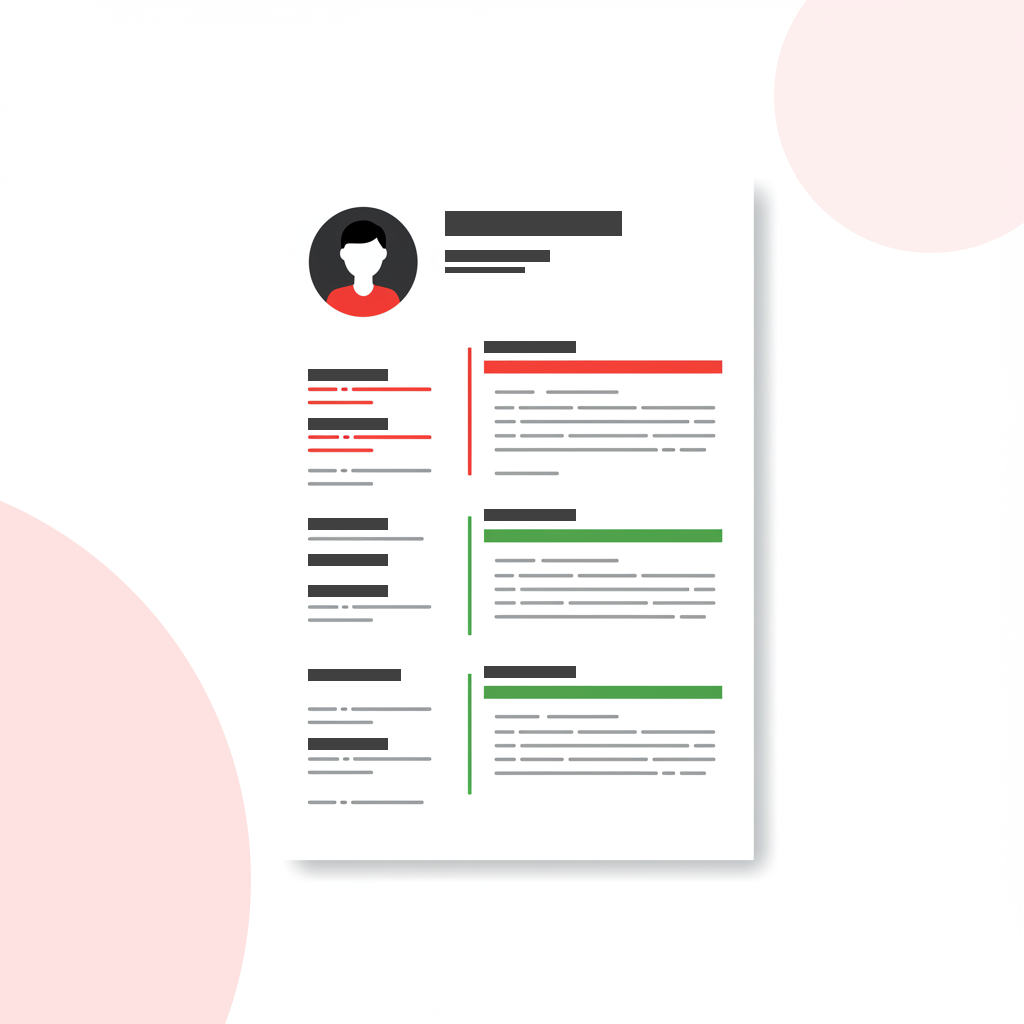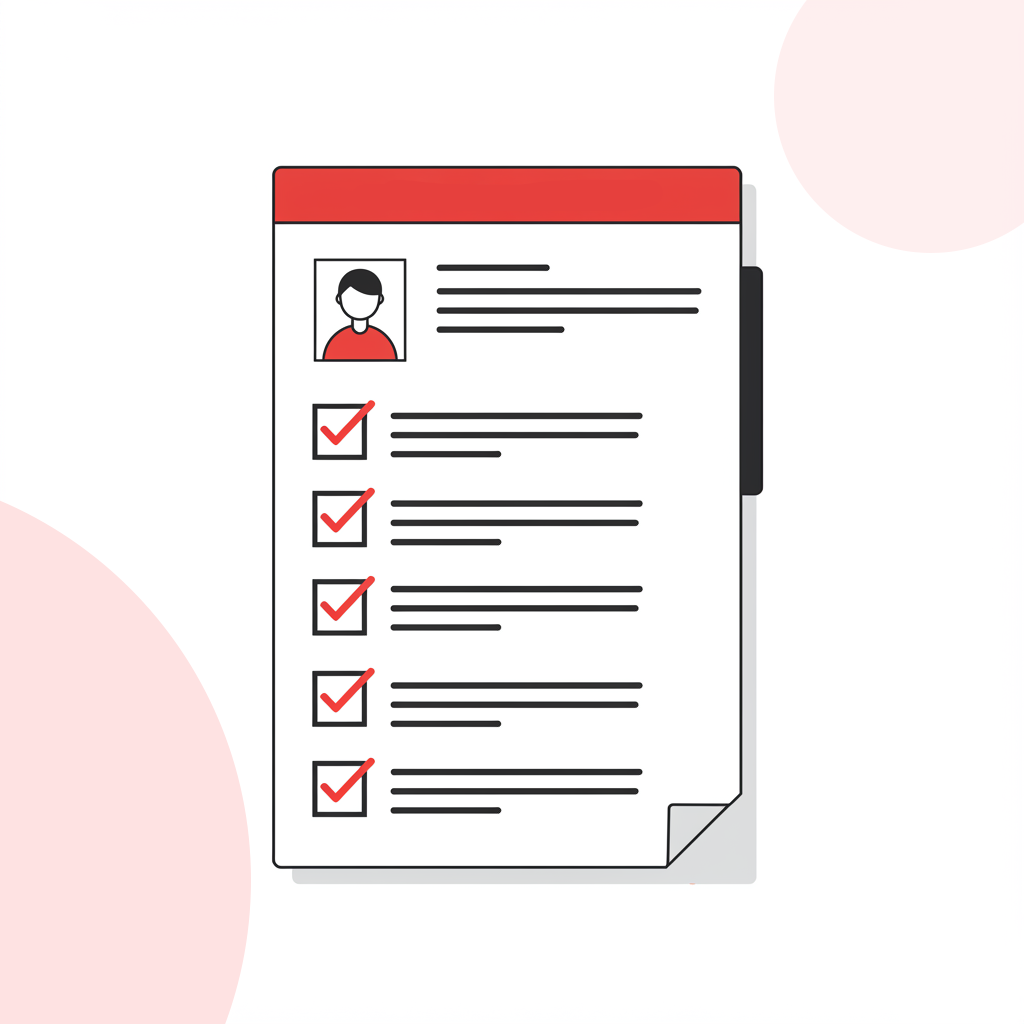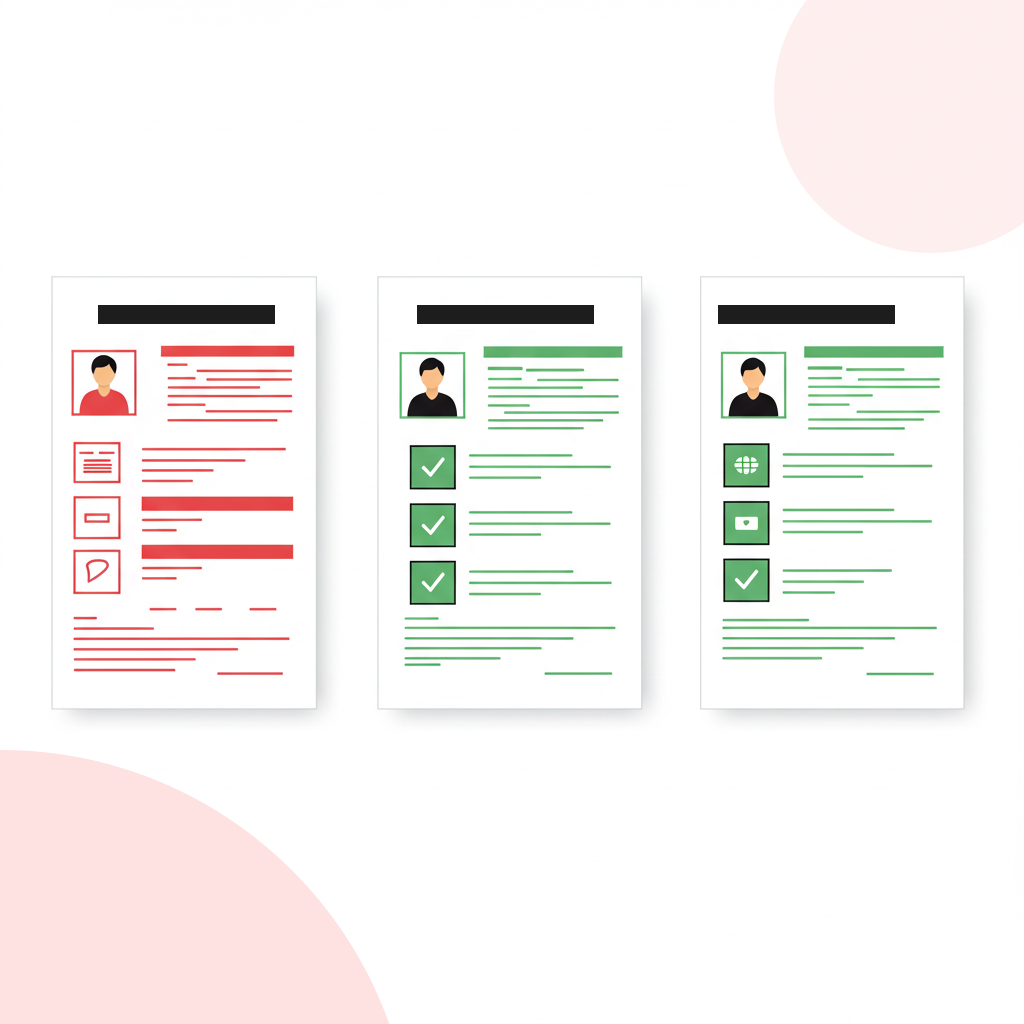A clear, organized layout will keep you on track. It will help you write your most relevant qualifications to make them stand out. Step by step, it’s the resume outline template that leads you to an interview. Creating a bad one can result in a missed opportunity.
Although they seem simple, resume outlines are essential during the writing process. They give you a structured framework to follow. Starting on a blank page is possible, but it may lead you to a complete mess if you don’t know how to write a resume. An outline already includes all important sections, such as contact details, work experience, education, and key skills. It also helps you maintain clarity, brevity, and relevance.
The outline is not just for beginners. It’s useful for anyone who’s working on a resume. Students need it because they don’t have enough experience, so they follow the outline to include academic achievements, internships, and extracurricular activities. Professionals can use outlines to match industry expectations and customize their experience in an easy-to-read way for any role they are interested in. Career changers benefit from an outline since it shows them where to include transferable skills and relevant accomplishments.
In this guide, we’ll break down the essential components of a resume outline and how to create this foundation, which will lead you to a well-structured application document.
What Is a Resume Outline?
A resume outline is a structured framework that guides you toward an organized resume. It’s the skeleton that ensures that all essential resume sections are properly structured and presented in a logical order.
If you start writing a resume from scratch, you might get confused with the advice out there: “Where should the contact details be? Does my work experience or professional summary come first? Where do I list my skills?” The outline solves the dilemma and gives you a clean structure to follow so that you can focus on the content. Outline's main purpose is to help you create a well-structured document that effectively shows your experience, skills, and achievements. It makes sure that key information is easy to find and formatted for readability.
Advantages of Using a Resume Outline
Keep in mind that outlines are not the same thing as resume builders. The outline only gives you structure. You (or a professional resume writer) are the one who puts content in it. A resume builder, on the other hand, is an AI-based tool that takes your details and delivers a complete resume. If you rely on AI, keep in mind that some heavy editing might be needed to add customization and a human touch.
These are the advantages of using an outline:
✅ It saves you time and effort as you’ll have a predefined structure to quickly fill in your details.
✅ The structured format ensures a logical flow. It makes it easier for recruiters and ATS to follow your career progression.
✅ You’re less likely to forget important sections, such as certifications, awards, or volunteer experience.
✅ An outline makes the resume easier to skim. It’s more likely for such a document to catch the eye of a recruiter or hiring manager.
✅ The outline will make it easy for you to adjust different sections for specific positions. You can use it to create a master resume and then edit it for each job application.
What the Outline Means for ATS Compatibility
Job applicants should be aware that most companies today use Applicant Tracking Systems - a software that filters resumes before they reach human recruiters. The resume outline can make a difference. Here’s how:
Great outlines are optimized for ATS since they follow a standard structure and include industry-specific keywords.
With an outline, you’ll avoid formatting issues, which could cause the ATS to misinterpret content.
When you check resume outline examples, you’ll notice they are highly organized. The template will help you keep the sections well-defined, which, in turn, means that ATSs will process them efficiently.
How to Write a Resume Outline: The Basic Structure
You start with the outline’s structure. It’s the foundation for a readable and professional-looking document. The structure can vary based on your industry and experience level. Still, most resumes follow a pretty common structure with standard sections.
Standard Resume Sections
Header (Name, Contact Information, LinkedIn, Portfolio)
The header is always the first section of your resume. It should contain these details:
Full name, as it appears on official documents
Phone number, which has to be a working number with voicemail enabled
Email address (make it sound professional, please!)
Location (City, State, Country) — It’s optional; include it if it’s relevant to the job. If you are looking for remote positions, indicate that instead of your location
LinkedIn profile and/or portfolio URL (adding a portfolio link is highly recommended for professionals in creative, tech, and marketing roles)
Summary or Objective Statement
This is an introduction of 2-4 sentences. It briefly outlines your experience, skills, and career goals. You can check out the resume summary examples we’ve shared to get inspired. Ideally, only choose one to start your resume. These are the main things to know:
A resume summary is for experienced professionals. It highlights their most important achievements. For example: “Marketing specialist with 9 years of experience in digital campaigns, SEO, and brand management. Proven track record in increasing engagement by 35% and leading high-impact content strategies.”
A resume objective focuses on aspirations and potential contributions. It’s perfect for entry-level candidates, career changers, or recent graduates. Here’s an example: “Recent business graduate with a strong foundation in market research and data analytics. Seeking to apply analytical and problem-solving skills in a marketing role.”
Work Experience
This section is the backbone of your document. Each job entry should include the following details:
Job title (Clearly state your position)
Company name and location (Mention the company and city)
Dates of employment (The Month/Year — Month/Year format is recommended)
Achievements and responsibilities (Use bullets to list measurables)
Here’s an example to show you how this section looks in real resumes:
Digital Marketing Manager | G Corp. | Jan 2019 — Present
Increased organic website traffic by 56% through content and SEO optimization.
Led a team of three marketers, improving efficiency by 29% with workflow automation.
Education
Here’s what to include in this section:
Degree earned
Institution name and location
Graduation year (or expected graduation year if you’re still in school)
Honors, GPA (if above 3.5), relevant coursework (for academic CVs, fresh grads, if relevant to the role)
Skills
The right combination of skills for a resume includes both hard and soft skills. This section presents them in bullet points or a categorized format.
Hard Skills — technical skills like programming, data analysis, and software proficiency
Soft Skills — communication, leadership, or adaptability
Here’s an example of what this section would look like:
Technical Skills: Python, SQL, Adobe Photoshop
Soft Skills: Team leadership, conflict resolution, critical thinking
Additional Sections
These sections are optional but are beneficial in certain cases as they add value to your resume, especially when applying for competitive roles. Truth be told, there’s no such thing as a non-competitive role nowadays, is there?
These are the additional sections you can include:
Certifications & Training — Relevant courses, licenses, and industry-recognized certifications
Languages — List language proficiency levels (Fluent, Intermediate, Basic)
Volunteer Work — Mention community involvement and transferable skills
Projects & Publications — Useful for tech, academic, and research-based careers
Awards & Honors — Present achievements beyond work and education
Resume Formats: Chronological, Functional, and Combination
There are three main resume formats that are suitable for different career situations:
Chronological Resume
It works well for professionals with experience. This format lists your work experience in reverse chronological order. If you’ve had a steady career path in the same field, you should definitely choose to present your experience this way. The chronological resume is the most commonly used format. It’s clear, straightforward, and preferred by recruiters. When they see that the candidate focuses on experience, they immediately notice there are no career gaps to hide.
Functional Resume
This format focuses on skills rather than work history. It works well for career changers, recent graduates, and freelancers with diverse experience. The outline groups the work experience by skill categories rather than job titles, which is useful for those with employment gaps since it makes them less visible.
Combination (Hybrid) Resume
This format combines chronological and functional resumes. It first lists the key skills and then presents a detailed work experience section. It’s great for most candidates, especially those with strong skills and relevant experience. Hybrid resumes are a common choice for senior professionals and job seekers with transferable skills across industries.
How to Choose the Right Resume Structure
The most suitable format will depend on a few factors:
Career stability: If you have a consistent experience to present in your resume, then the chronological or hybrid format will work well for you.
Career change: A functional or combination resume is better. It will present your transferable skills. You can check out our military resume writing tips to see how transferable skills should be included in a resume for a military-to-civilian transition.
Entry-level job: You don’t have that much experience to share? You can always use a functional or hybrid approach to highlight your education and skills.
Technical roles: Job applicants who want to share their technical expertise and work history often go for a hybrid resume.
Step-By-Step Resume Outline Sample Guide
To make a strong impression on recruiters and pass ATSs, you need a resume with a strong structure. Here are some tips on how to complete each section.
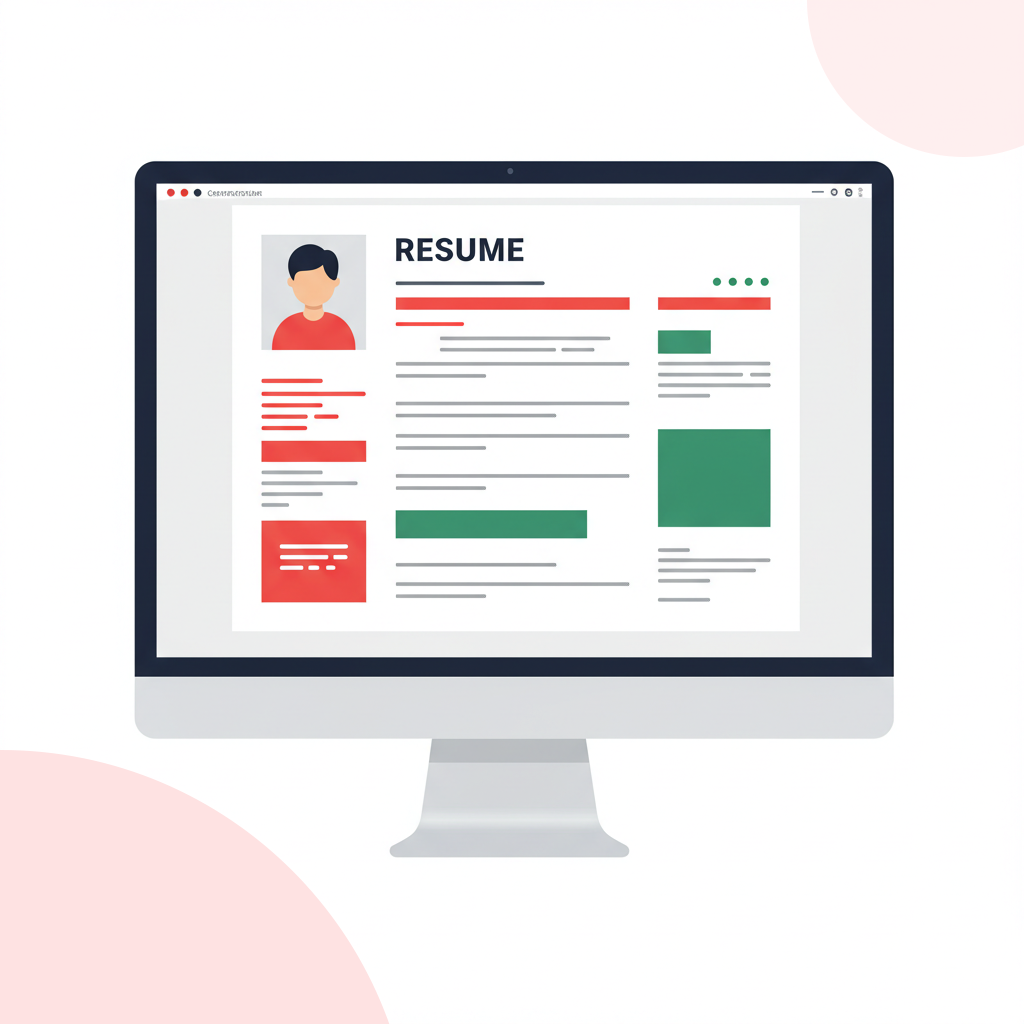
Header & Contact Information: Keep It Professional
This is the very first section that recruiters see. It has to be clear and professional.
These are the best practices to follow:
Full Name — Use your professional name as it appears on official documents
Phone Number — Provide a valid cell phone number where recruiters can reach you
Email Address — Avoid nicknames and use a professional email
LinkedIn Profile & Portfolio — It’s particularly useful for marketing, IT, and creative professionals
Location — If necessary, list only the city and state/country
Job applicants commonly make some mistakes that are easy to avoid:
❌ Listing an unprofessional email, such as coolgal85@email.com
Here’s an example of how this section should look:
Resume Summary or Objective: Keep It Short and Impactful
Both the summary and objective are introductory statements. You write them at the top of your resume after the contact details. Remember that they serve different purposes, so ideally, you can’t have them both in the same application. The informal rule is that experienced candidates should use a summary, while new graduates and career changers should opt for an objective.
Whatever your choice is, you should keep it short but powerful. There’s no space for fluff in the summary or objective. Focus on your strengths and top measurable achievements in 2-3 sentences that make a good impression. Generic summaries won’t work! You should tailor this section to the specific job opening, so mention skills and experiences that match the job description.
Skills: Pass the ATS
There's one main rule to follow when it comes to this section: job-relevant skills take priority. You shouldn’t list every skill you have. Instead, group your skills into categories, such as Technical Skills, Software Proficiency, or Management Skills. You can also integrate your skills into other sections. For example, when writing about your work experience, show your project management skills. Here’s an example: “Led a team of 10 to complete a $500K project on time and under budget.”
Work Experience: Tell a Story with Numbers
Each job entry should include the following details:
Job title (bolded to make it stand out)
Company name and location
Dates of employment
Achievements and responsibilities
There’s not much experimenting with the structure of this section. These are the details that employers want to see, and you should provide them. When a hiring manager looks at your work experience, they should see a story, not just a description. You can use resume action verbs and quantify the results to catch their attention.
Education: Make It Work for You
The education section doesn’t have to be dry. Instead of just listing your GPA, you can write something like “Graduated in the top 5% of the class” or “Dean’s list for four consecutive years.” This is especially important for college grads looking for jobs, internships, or writing an academic CV in pursuit of a Master's or PhD. For seasoned professionals, this section might be less important. We would also recommend avoiding adding graduation year if you graduated over 10 years ago to prevent age bias.
Optional Sections: Add Value & Uniqueness
Don't skip this if it adds value to your job search! A section for certifications and attended conferences will show that you are dedicated to continuous improvement and learning. If multilingual skills are relevant, you can add a Languages section (or simply mention this in your resume summary). Specify the fluency level for each language, and please be honest. The employer should know what to expect.
If you decide to add a section for your projects and portfolio - make it a working (!) link to the real samples. This is essential for developers, designers, writers, and applicants in other creative industries. A Volunteer Work section can also serve a purpose if it adds substance to their experience and shows leadership, teamwork, and industry-relevant skills.
Customize Your Resume Outline for Different Jobs
The standard resume structure works in most cases, but it’s somewhat flexible. You can customize it for different job types and industries if the standard type doesn’t work for you.
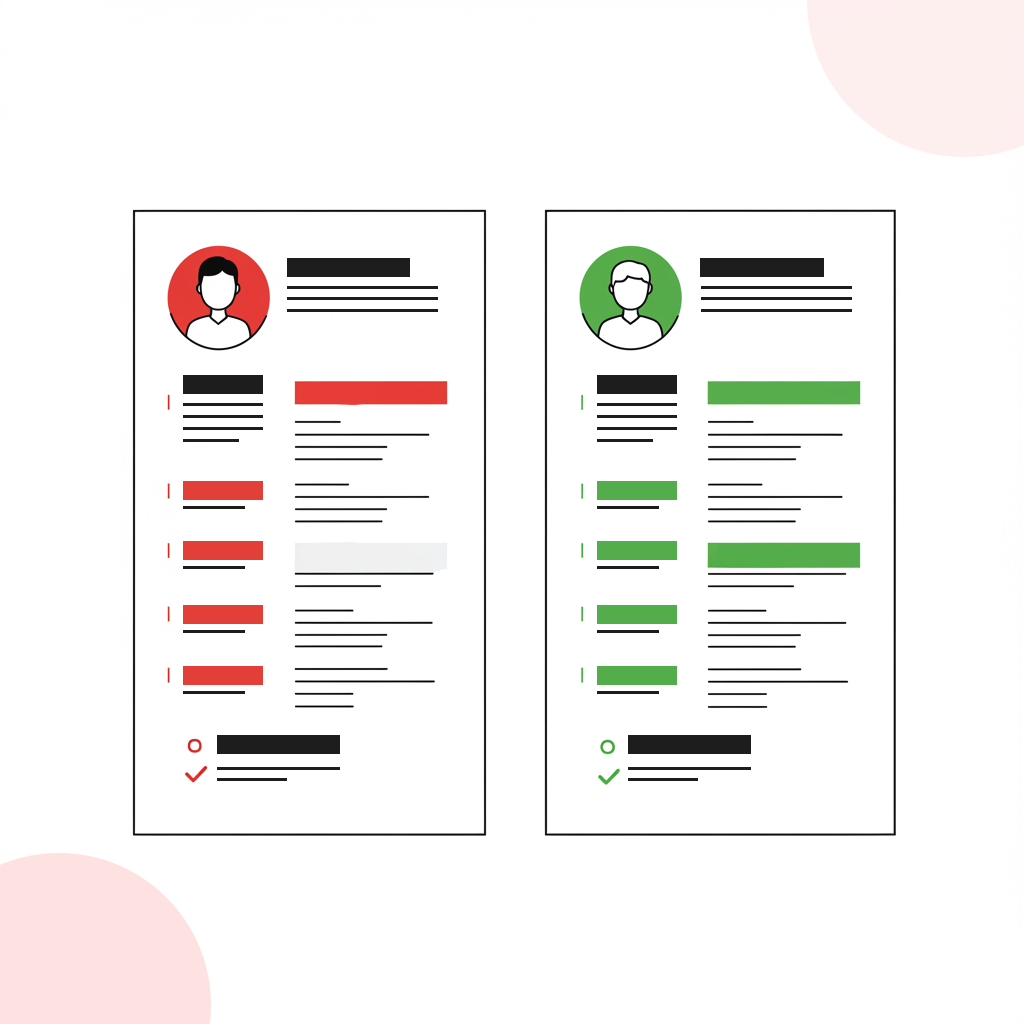
Entry-Level Job Seekers: Focus on Potential Over Experience
Since you don’t have too much work experience to share, you can emphasize your skills.
For example, when you’re listing your work experience, “Worked as a cashier at a local store” won’t work. Be more detailed, like this: “Provided exceptional customer service, handling 100+ transactions daily while resolving issues to ensure customer satisfaction.”
Since you need the resume to work for the specific position, you can mention transferable skills: communication, teamwork, and adaptability. You can also mention relevant coursework.
Employers are aware that these are entry-level positions. They want to hire a candidate with relevant knowledge and skills. To show you can handle the role’s responsibilities, list any relevant academic projects, research, volunteer work, and internships.
For an entry-level resume, it’s the objective that makes a big difference. A well-written resume objective shows enthusiasm and a willingness to learn.
Career Changers: Show Relevant Skills and Achievements
We recommend the combination resume format in this case. It helps highlight your skills so they will overshadow the unrelated work history. Start by identifying the common skills between your past roles and the new field. Then, write about those transferable skills.
Your summary or objective has to be powerful. Clearly explain why you’re making this transition and how you can apply your skills to this new career path.
Here’s an example of a summary that would work: “Marketing professional transitioning into UX design. Advanced data analysis and audience engagement expertise for delivering user-centric experiences. Completed Google UX Certification.”
Senior Professionals and Executives: Underline Leadership
If you’re ahead on your career path, the summary must make a strong impact in summarizing (pun intended) your career in two short but powerfully worded sentences. It should show your leadership, strategy, and revenue-driving achievements. Throughout the resume, you’ll focus on results instead of mere experience. This would work: “Led a $10M product launch, increased market share by 15%.”
To keep your resume within the acceptable length (1-2 pages), you should avoid listing every job from the past 20 years. Focus on the last 10-15 years, max.
Freelancers and Gig Workers: Prove Credibility and Versatility
A standard resume may not be enough for a freelancer. They don’t have a traditional major experience, but they can make up for it. If you’re in this industry, you should list major clients and your most important projects. The point is to show results, not just services provided. Mention impacts, such as revenue growth, traffic increase, or campaign success. Since these details aren’t always available to freelancers, you can mention if you were top-rated on freelancing platforms, such as Upwork.
If applicable, definitely link to a personal website that shows your work. Here’s an example of how work experience can look for a freelancer:
Freelance Digital Marketer | 2018 - Present
Optimized SEO for 26 clients. Increased organic traffic by an average of 40% within six months.
Industry-Specific Resume Variations
We’ll give you brief tips on how to outline industry-specific resumes.
Tech (Software Engineering, IT)
- Focus on programming languages, frameworks, and tools.
- Include personal projects or GitHub repositories.
- Use metrics like this: “Reduced system downtime by 30% through automated deployment.”
Healthcare (Nurses, Medical Assistants, Physicians)
- In the outline, your licenses and certifications should come up front.
- Show patient outcomes like this: “Managed 20+ patients daily, improving patient satisfaction scores by 15%.”
Marketing and Creative Fields
- These professionals should demonstrate their work on campaigns with data. Like this: “Led a rebranding project that increased engagement by 50%.”
- In the outline, indicate space for your portfolio link.
Finance and Business
- Focus on cost savings, revenue growth, and process improvement.
- Use financial figures wherever possible.
Resume Outline Sample Formatting and Design Tips
The format is everything! With a properly formatted outline, you’ll improve the readability of the final result. These are the main things to focus on:
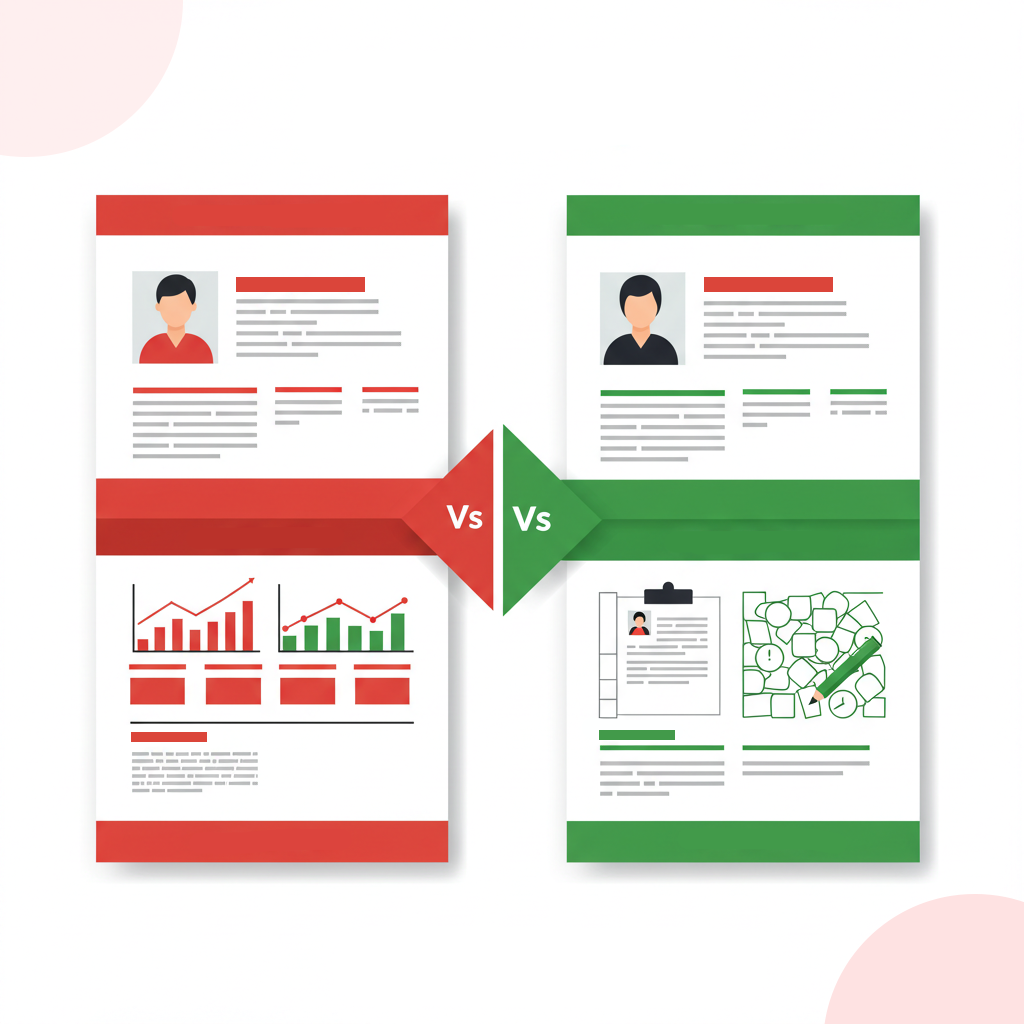
Font, Spacing, and Margins
When choosing a font, getting creative is not the right thing to do. Keep it simple and professional.
Classic fonts are the best: Arial, Calibri, Garamond, Georgia, and Helvetica. Avoid overly stylized or script fonts, such as Comic Sans or Papyrus, even if you’re in the creative industry.
The font size should be 10-12 pt for body text and 14-16 pt for headings. Smaller than 10 pt for the body text will make your document unreadable. But if you go above 12 pt, it will look unprofessional. Increasing the font with the intention to achieve the desired length will definitely backfire on you.
The margins should be set between 0.5 and 1 inch on all sides. That’s important to avoid clutter. As for line spacing, the standard is 1.15-1.5, so you’ll improve the readability of your document without making it look unprofessional.
Break up the sections with bold headings or subtle dividers.
Don’t play with the color or background. Stick to the basics: black or dark gray text on a white background is perfect for readability and ATS compliance.
Resume Outline Template for Different Industries
Traditional and Corporate Fields (Finance, Law, Healthcare, Education, Administration)
- Use a clean, black-and-white template with clear sections.
- The reverse chronological format works well for readability.
- No images, graphics, or fancy fonts! Keep it strictly professional, even if it looks boring from your perspective. Hiring managers are focused on content, not form!
Creative and Design Fields (Marketing, Graphic Design, Media, UX/UI, Fashion)
- A black-and-white template is still the best choice. But you can use color accents for a personal touch. The color choice must still look professional, so go for navy or dark green.
- Infographics, subtle icons, and creative layouts can work in this industry because they visually showcase your skills.
- A link to a personal website or portfolio is a must! That’s the space where you really show your creativity.
Tech and Startups (Software Engineering, Data Science, IT, Product Management)
- Stick with a sleek, simple template with clean fonts and structured sections.
- Opt for ATS-friendly formatting. So no tables, fancy columns, or excessive icons.
- Plan the outline to present your skills and technical proficiencies in a dedicated section.
One-Page vs. Two-Page Resume: Which One to Choose
We have a comprehensive guide on how long a resume should be, so check it out for more details. In essence, these are the basic rules to follow:
A one-page resume works for entry-level job seekers and those with less than 10 years of experience. Freelancers and career changers can also go for this length since they focus on core skills over extensive job history. Some industries strictly prefer concise resumes. If you’re targeting a position in marketing or tech, a one-page resume may be enough.
Senior professionals and executives with 10+ years of experience will need more space to present their relevant experience. Some resumes also need a detailed project list. That’s the standard for roles in academia, research, and engineering. Industries like healthcare, law, and finance also emphasize experience, so you’ll need to go beyond the first page.
When to Get Visuals in the Resume Outline
The rule is to go with a traditional outline if you’re applying for corporate, government, or legal jobs. When you know that the company uses an ATS, avoid creative designs because they may get rejected in the first stage of the filtering process. Check the job description, too. If it asks for a formal and structured resume, don’t ignore that requirement.
Is it allowed to get creative with resumes? If you’re in design, marketing, or media, you may benefit from a small dose of oomph in your resume. Startups may also appreciate a creative touch. If you have graphic design skills that are relevant to the job and you want to show your creativity, you can opt for a graphic resume.
It’s important to check the company’s standards and culture before you start with the outline. If it encourages unique applications, you can get creative. In any other situation, stick to a sleek, traditional resume.
Resume Outline Template
Start with a blank outline that includes the essential sections of a resume. This template can be adapted to your career level and industry. It serves as a canvas to fill in your personalized details. Need more inspiration? We have a library of elegant and ATS-approved resume samples for you to review.
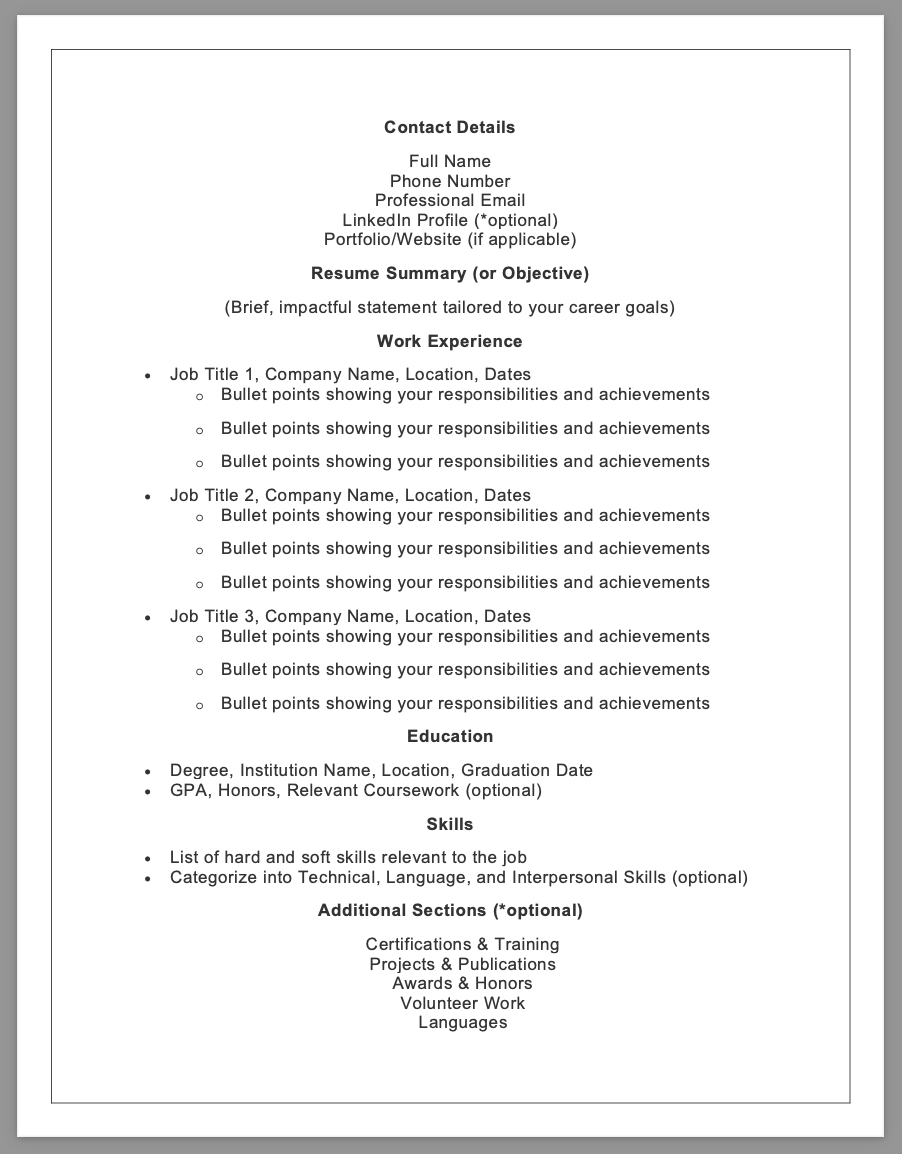
Overview
Creating a compelling resume is an ongoing process that starts with a well-organized outline. In this guide, we explored the essentials. If you need any assistance with the outline or the entire application, you can count on our service. Resumeble offers professional help at every stage of the process.
FAQs
A: A resume outline is a structured framework that helps you organize all sections of your resume before you start writing. It’s great to have one since it helps include all important information: contact details, work experience, education, and skills.
Q: Should I use a resume summary or an objective?
A: The choice depends on your experience level. If you have several years of experience, the summary will encompass them beautifully. But if you’re an entry-level candidate or changing careers, you don’t have much to summarize. In that case, go for the objective!
Q: How often should I update my resume outline?
A: You should do it regularly. Ideally, update the outline after every significant milestone, project, or new skill acquisition. Keeping the outline current ensures that you’re ready to apply for new opportunities as they arise.

